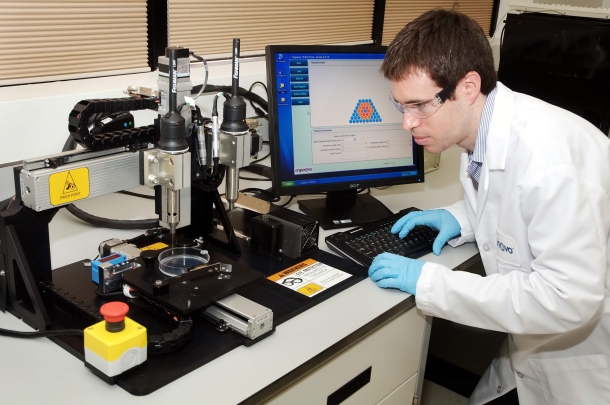Dynamics of Matter
1.Responsiveness of Materials
As stated in the first part of this essay, matter interacts based on different vibrational frequencies. Smart materials are being conceived according to studies of perceptive and responsive abilities of material. Polymers have been exploited also for medical applications. Ferrofluid, an oily liquid made of nanoscale ferromagnetic particles, suspended in a carrier fluid that reacts to magnetic fields, has several applications in our daily life thanks to its properties. It is for example used to seal spinning drive shafts in hard disks. Lately it has been applied in the experimental cure for tumors, thanks to the ability of the nanoparticles to convert electromagnetic energy into thermal energy or heat, that could kill the desired cells without damaging surroundingtissue.

The emerging field of biomimetics has given rise to new technologies created from biologically inspired engineering at both the macro scale and nanoscale levels.
2.Molecular Manipulation
Biomimicry is a practice based on the examination of nature, its models, systems, processes, and elements to emulate, or take inspiration from, in order to solve human challenges. Janine Benjus declared that a holistic picture of nature’s systems can be directly applied to our human systems. By looking at sharks, scientists have been able to replicate dermal denticles in swimsuits that allowed olympic swimmers to go faster. According to biomimc logic, researchers are trying to uncover key design principles that nature uses to build living things. Created by a process of hierarchical self-assembly, the process that allows molecules to make cells, cells to make tissues, and tissues to give rise to whole organisms, living materials can grow, move, learn, and self-organize. They are responsive, adaptive, programmable, self-healing, stable, and engineered to reproduce specific actions. Hence natural materials are also uniquely multifunctional as they can serve simultaneously as mechanical frameworks, chemical factories, light-conducting conduits, electric field generators, energy harvesters, and information processing networks. Revolutionary steps are taken at the Laboratory Organovo based in San Diego (fig.17), where biophysicst Dr. Gabor Forgacs and his team are working on creating functional human tissues using three-dimensional bioprinting technology. The printed material comes from two ink-jet cartridges. One is filled with cells, the other with a hydrogel, which acts as a scaffold. First the hydrogel structure is printed, then the cells onto it. Within 24-48 hours the cells fuse around the structure to form a usable organ.

3.Synthetic Living-beings
In application of engineering lessons, derived from natural living systems to create artificial materials, enormous challenges are being faced. Recently material scientists at the Harvard School of Engineering and Applied Sciences have found a way to control the growth behavior of crystals to create precisely tailored structures - such as micro-scale flowers- by simply manipulating chemical gradients in a beaker of fluid.

Researches at MIT Media Lab are exploring biological and mechanical properties of synthetic materials developing objects and structures inspired by the laws of nature. At the core of Neri Oxman’s visions lies the desire to potentiate our bodies and the things around us with an intelligence that will deepen the relationship between the objects we use and which we inhabit, and our environment. Cartesian Wax (fig.19) is a prototype for an environmentally responsive skin. The work promotes the integration between the structural and environmental elements of the skin. The structural elements provide for an optimized distribution of load, while the environmental elements allow for the infiltration of light and heat to and from within the skin.
![]()
Skylar Tibbits’ research currently focuses on developing self-assembly technologies for large-scale structures. He called “4D printing” the practice of using smart materials to make objects that change shape and evolve. Logic Matter is based on the NAND truth table used in computing defining ‘binary’. This offers possibilities in terms of self-replication as all the instructions are embedded into the structure or system needing no external source. These low level simple bits combine to create a much more complex structural system.

London architecture team Softkill Design has designed a conceptual 3D printed house. The structure of the house was generated using an algorithm that imitates bone growth to deposit material where it is needed along lines of stress, resulting in a fibrous web rather than a solid envelope. Cladding materials and roofing could be printed as flexible fabrics and be draped over buildings.

4.Questions
Nowadays 3D printing technology represents the latest frontier for a new model of living. A paradigm shift has occurred in the past decades substituting the World-as-Machine view of the industrial revolution, with a more holistic perception: the World-as-Organism. This new model inspires a desire to instill intelligence into objects, buildings and cities. Can the vibrational frequencies of our body affect our environment? How can we communicate with matter? Can matter shape automatically according to our behaviour? Can a space respond intelligently to our needs?
